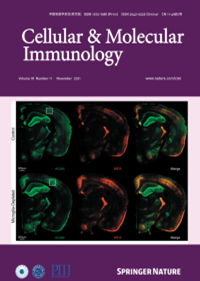PANoptosis in cancer: bridging molecular mechanisms to therapeutic innovations
IF 19.8
1区 医学
Q1 IMMUNOLOGY
引用次数: 0
Abstract
PANoptosis, a newly defined inflammatory programmed cell death, plays key roles in tumor development and progression. This process involves the assembly of PANoptosome complexes under various stimuli, which activate multiple cell death pathways simultaneously. By integrating key sensors and effector molecules, PANoptosis enhances immunogenic cell death while counteracts immune evasion mechanisms. This review focuses on current research of PANoptosis in cancer. Clinically, PANoptosis-related signatures show clinical value for predicting patient survival, discerning tumor immune microenvironment (TIME) characteristics and evaluating the therapeutic response. Mechanistically, complex signaling networks regulate PANoptosis, which in turn influences tumor behavior through dynamic interactions with TIME components. Therapeutically, targeting PANoptosis-related pathways, including nanomedicine approaches, demonstrate encouraging preclinical results. Particularly, combining PANoptosis modulation with radiotherapy, chemotherapy, or immunotherapy enhances anti-tumor efficacy. These findings position PANoptosis as a promising therapeutic target for reshaping TIME, overcoming treatment resistance, and improving cancer outcomes. Future research will focus on elucidating context-dependent PANoptosome regulation and translating these insights into precision oncology strategies.

PANoptosis在癌症中的应用:连接分子机制与治疗创新。
PANoptosis是一种新定义的炎性程序性细胞死亡,在肿瘤的发生和发展中起着关键作用。这一过程涉及PANoptosome复合物在各种刺激下的组装,同时激活多种细胞死亡途径。PANoptosis通过整合关键传感器和效应分子,增强免疫原性细胞死亡,同时抵消免疫逃避机制。本文就PANoptosis在肿瘤中的研究进展作一综述。临床上,panoptosis相关特征在预测患者生存、识别肿瘤免疫微环境(TIME)特征和评估治疗反应方面具有临床价值。在机制上,复杂的信号网络调节PANoptosis,进而通过与TIME组分的动态相互作用影响肿瘤行为。在治疗上,靶向panoptoosis相关通路,包括纳米医学方法,显示出令人鼓舞的临床前结果。特别是,PANoptosis调制与放疗、化疗或免疫治疗相结合,可提高抗肿瘤疗效。这些发现将PANoptosis定位为重塑TIME、克服治疗耐药性和改善癌症预后的有希望的治疗靶点。未来的研究将集中于阐明上下文依赖性PANoptosome调控,并将这些见解转化为精确的肿瘤学策略。
本文章由计算机程序翻译,如有差异,请以英文原文为准。
求助全文
约1分钟内获得全文
求助全文
来源期刊
CiteScore
31.20
自引率
1.20%
发文量
903
审稿时长
1 months
期刊介绍:
Cellular & Molecular Immunology, a monthly journal from the Chinese Society of Immunology and the University of Science and Technology of China, serves as a comprehensive platform covering both basic immunology research and clinical applications. The journal publishes a variety of article types, including Articles, Review Articles, Mini Reviews, and Short Communications, focusing on diverse aspects of cellular and molecular immunology.

 求助内容:
求助内容: 应助结果提醒方式:
应助结果提醒方式:


